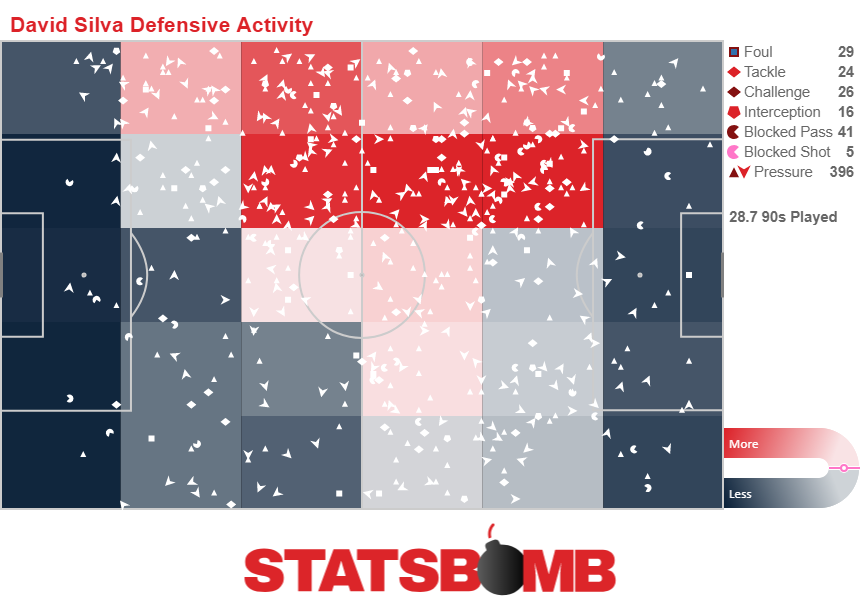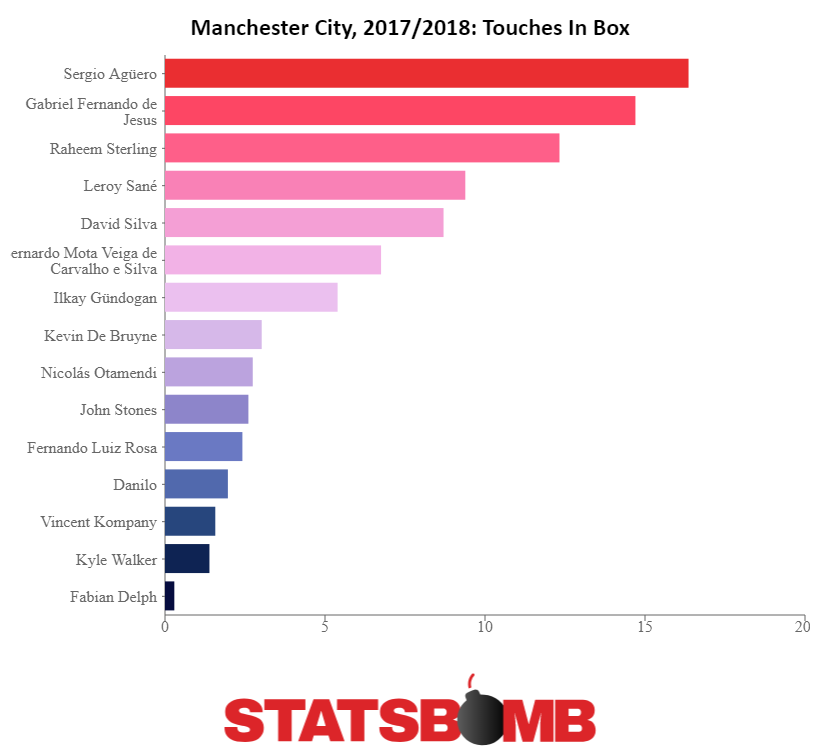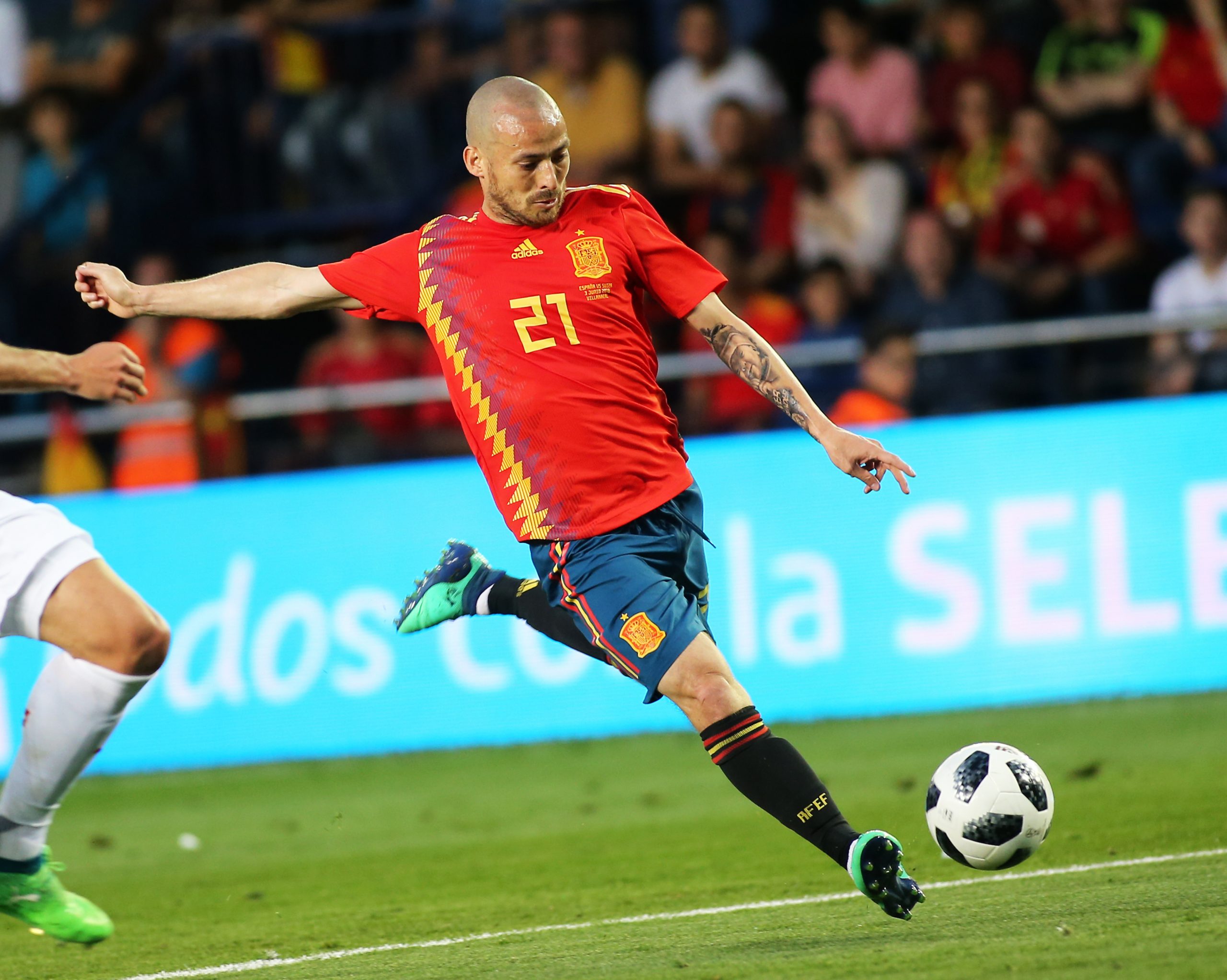The first marquee match of the 2018 World Cup is Spain against Portugal. The match had enough drama to stand on its own merits, one of the favorites to win the tournament playing against the current champions of Europe, and that was before a chaotic 48 hour whirlwind laid waste to Spain’s camp. In the space of two days Spain’s manager Julen Lopetegui was hired to manage Real Madrid, announced the news suddenly before it leaked, and then was fired over how it all went down. The chaos stands in stark contrast to what has been a very stable Spain team over the last two years. Lopetegui built his team around Spanish midfielders, and in particular made a seemingly curious but successful decision to play David Silva on the right wing. Silva’s role seems strange at first, but break down his season and it begins to make sense.
Silva at Manchester City
The idea of the “free eight” is a new one. It’s basically a midfielder with the traditional playmaking duties and positional freedom of the classic ten, but one who takes up a slightly deeper midfield position. David Silva occupies that roll to a tee for Manchester City. He’s a defensive pressure machine on the left side of the midfield.  He also routinely feeds balls into the attacking penalty area. He and Kevin de Bruyne excelled at getting the ball in space, turning and sliding players into the attacking Penalty area.
He also routinely feeds balls into the attacking penalty area. He and Kevin de Bruyne excelled at getting the ball in space, turning and sliding players into the attacking Penalty area.  Of Premier League players with over 900 minutes, Silva was fifth with 2.99 open play passes into the penalty area per game. Only Alexis Sanchez (of the Arsenal variety), De Bruyne, Philippe “no longer appearing in this league” Coutinho, and Mesut Ozil had more. It’s clear just how much City relied on the passing of their midfielders. That’s not at all surprising. This is what Pep Guardiola teams do. They get great passers into dangerous areas and then use them to spring goal scorers for great chances. In that manner Silva and De Bruyne look very similar. But, looking at them from a different angle, the midfielders differ to a large degree along another important axis. Silva also has this annoying (for opposing defenses anyway) habit of getting into the penalty area. He takes 8.70 touches in the box per 90 minutes, that’s way more than De Bruyne’s 3.02. It’s much closer to winger Leroy Sane’s 9.38, or even winger and also kind of forward Raheem Sterling’s 12.33 than De Bruyne.
Of Premier League players with over 900 minutes, Silva was fifth with 2.99 open play passes into the penalty area per game. Only Alexis Sanchez (of the Arsenal variety), De Bruyne, Philippe “no longer appearing in this league” Coutinho, and Mesut Ozil had more. It’s clear just how much City relied on the passing of their midfielders. That’s not at all surprising. This is what Pep Guardiola teams do. They get great passers into dangerous areas and then use them to spring goal scorers for great chances. In that manner Silva and De Bruyne look very similar. But, looking at them from a different angle, the midfielders differ to a large degree along another important axis. Silva also has this annoying (for opposing defenses anyway) habit of getting into the penalty area. He takes 8.70 touches in the box per 90 minutes, that’s way more than De Bruyne’s 3.02. It’s much closer to winger Leroy Sane’s 9.38, or even winger and also kind of forward Raheem Sterling’s 12.33 than De Bruyne.  The combination of playing a lot passes into the box and also getting a lot of touches in the box is a rare one. Usually high numbers of touches in the box are the provenance of out and out strikers. Guys like Sergio Aguero, Harry Kane and Alexander Lacazette led the league this season along with Mohammed Salah who while not a pure striker was mostly a god, so he gets included. They were the only four players to get over 15 touches a game. But, when you narrow down the list to looking at players who both create and get into the box something interesting happens. There were only four Premier League players last season who had both more than two open play passes per 90 into the penalty box and more than eight touches in the penalty area. Silva, Sanchez, Sadio Mane, and Eden Hazard. In that company David Silva looks less like a midfielder and more like a winger who has been crammed into the midfield. There are important differences, of course. Silva is a much less prolific shooter than the other guys. He shot only 2.09 times per 90 minutes, even Hazard, who is the second least shot happy of the group shot it 2.50 times. And all these other wingers seem to spend lots of time in the box because they dribble the ball there. Silva seems to show up by magic. He only completed 0.66 dribbles per 90, the rest of them were all over 1.5 with Sanchez the highest at 3.25.
The combination of playing a lot passes into the box and also getting a lot of touches in the box is a rare one. Usually high numbers of touches in the box are the provenance of out and out strikers. Guys like Sergio Aguero, Harry Kane and Alexander Lacazette led the league this season along with Mohammed Salah who while not a pure striker was mostly a god, so he gets included. They were the only four players to get over 15 touches a game. But, when you narrow down the list to looking at players who both create and get into the box something interesting happens. There were only four Premier League players last season who had both more than two open play passes per 90 into the penalty box and more than eight touches in the penalty area. Silva, Sanchez, Sadio Mane, and Eden Hazard. In that company David Silva looks less like a midfielder and more like a winger who has been crammed into the midfield. There are important differences, of course. Silva is a much less prolific shooter than the other guys. He shot only 2.09 times per 90 minutes, even Hazard, who is the second least shot happy of the group shot it 2.50 times. And all these other wingers seem to spend lots of time in the box because they dribble the ball there. Silva seems to show up by magic. He only completed 0.66 dribbles per 90, the rest of them were all over 1.5 with Sanchez the highest at 3.25.
Silva for Spain
The fact that the numbers paint him like a weird little magical winger for Manchester City help to better explain his role for Spain. Spain grows creative midfielders. I assume that somewhere next to the riojo vines the slick passing midfielders grow until they are harvested aged for 16-18 years and then released on the world. Even before looking at the players in Spain’s squad, just look at the set of midfielders that didn’t make the cut. Juan Mata, Cesc Fabregas, and Asier Illaramendi, for example, would all get into the squad for about 28 of the 32 teams in the tournament at minimum. Spain didn’t bother because they’ve got Silva, Andres Iniesta, Thiago, Isco, Koke and Saul (to say nothing of Sergio Busquets backstopping them). How exactly to cram all those players onto the field at once is an interesting problem. If all you did was take a quick glance at Silva’s topline numbers it wouldn’t suggest that he was the best candidate to get bumped out to the wing. Isco shoots more and spends at least part of his time at Real Madrid in that role, Iniesta has played there more over the course of his career, and with Silva being so good as a free eight, why move him? The answer is that part of what made Silva so good as a free eight was his ability to basically play as a stealth third winger. And, as it turns out, when he took on the role for Spain, in the absence of the kind of high quality goal scoring he was surrounded by at Manchester City, he stepped up that part of his game as well. Silva scored five goals over Spain’s qualifying campaign, leading the team. The way Silva interpreted his free eight role translated perfectly to the right wing. He gets to do most of the same stuff, but also be a more aggressive scorer. That’s not to say that playing him there is necessarily Spain’s best option. Whenever a team has so many similar players to fiddle around with there are bound to be multiple solutions and an abundance of ways to align the pieces. It's just that, despite appearances, Silva’s Premier League numbers suggest that he was incredibly well equipped to play on the wing, and UEFA qualifying bore that out. If Spain beat Portugal (or if they don’t but advance anyway) and make a deep run in the tournament it will be in part due to Silva’s goal scoring contributions. He carried the load in qualifying and he’ll need to do it again during the tournament. It might seem odd, but given how the team has decided to play it’s worked. If they remain stable on the field despite the chaos around them they'll be one of the few teams that could walk away World Cup champions. (Header Image Courtesy of Press Association)
